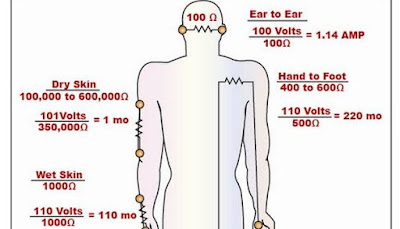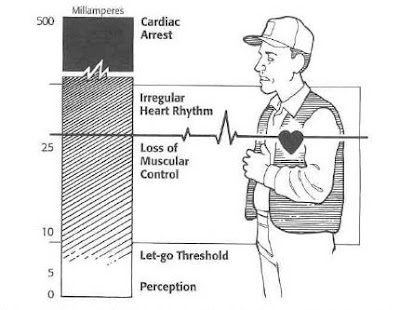Alternating Current (AC) and Direct Current (DC) have slightly different effects on the human body, but both are dangerous above a certain voltage. The effect on a particular person is very difficult to predict as it depends upon a large number of factors like amount of current, duration of flow, pathway of current, voltage applied and impedance of the human body.
AC is more dangerous when compared with the DC because of the following reasons:
To produce the same excitatory effects, the magnitude of DC flow of constant strength shall be two to four times greater than that of the AC i.e. more DC current is required to induce the same harmful effects as AC current.
Why?
The main difference between the effects of AC and DC on the human body result from the fact that excitatory actions of the current are linked to the changes of the current magnitude especially when making and breaking the current. Excitatory actions of the current include stimulation of nerves and muscles, induction of cardiac atrial or ventricular fibrillation. To produce the same excitatory effects, the magnitude of DC flow of constant strength shall be two to four times greater than that of the AC.
Ventricular Fibrillation is a condition in which there is uncoordinated contraction of the cardiac muscle of the ventricles in the heart. Because there is no co-ordinated contraction of the ventricles, there is no significant cardiac output, thus fulfilling the conditions of a cardiac arrest. Because of which a person may die.
Ventricular Fibrillation is considered to be the main cause of death by electric shock. The probability of a human suffering from Ventricular Fibrillation is much higher in the case of AC than DC.
Why?
For shock durations longer than the cardiac cycle, the threshold of ventricular fibrillation for DC is several times higher than for AC. For shock durations shorter than 200 milli seconds, the threshold of fibrillation is approximately the same as for AC measured in RMS values.
The total impedance of the human body is higher for DC and decreases when the frequency increases.Since the impedance for DC is higher, the severity of electric shock would be comparatively lesser than AC.
Why?
The impedance of the human body is one of the factors influencing the effect of electrical current on humans. The total impedance of the human body depends upon a number of factors including the frequency of electrical supply. Therefore, the impedance of the human body is higher for DC and decreases when the frequency increases.
It’s comparatively easier to let go of the gripped ‘live’ parts in the case of DC than AC.This is in contrary to popular belief.
What is the popular belief in this regard is that, AC would allow our muscles enough time to pull our limb away from the Live part because of the alternating cycles (AC frequency) which pass through zero. DC current, on the other hand, has continuous flow due to the absence of frequency oscillations and therefore you can’t pull your limb away from the Live part.
But the “let-go” current is the best experimental measure we have of the effect of electricity on humans. The “let-go” current is the lowest level of current passing through a human body through an electrode held in the hand that makes the human body unable to open his hand and drop the electrode. As mentioned in the IEC publication 60479 – Effects of current on human beings and livestock, the let-go of parts gripped is less difficult in the case of DC. This is based on experimental evidence.
Given the above reasons, we can safely conclude that AC is more dangerous than DC.
The effect of current on human body is shown in figure below.
Conclusions from above figure:
- If the current through a human body is between 0-5 mA, we get the perception of shock only.
- If the amount of current through the body is more than 10 mA then we get shock. This is also the let-go threshold.
- If the current is 25 mA then control to muscle is lost and death may occur.
So be safe. Take every precaution while working on live circuit. Thank you!



1. “…very difficult to predict as it depends upon a large number of factors like amount of current, duration of flow, pathway of current, voltage applied and impedance of the human body…”
2. There are typographical errors in the first fig.
a. Ear to ear 100* V/100 Ohm = [1.14 AMP ]** should be 1.0 A.
b. Dry skin 101* V/350,000 Ohm = [1 mo] *** should be 0.000288…A or 0.288… mA.
c. Wet skin 110 V/ 1000 Ohm = [110 mo] *** should be 0.11 A or 110 mA.
d. Hand to foot 110 V/500 Ohm = [220 mo] *** should be 0.22 A or 220 mA
3. In above a and b , why 100* V and 101* V are used ? Could it be a typographical error which should be 110 V as used in c and d; the voltage which is frequently used in both AC and DC circuits.
4. The SI unit name for electric current is ampere, unit symbol is A. NOT [ mo]***.
Che Kuan Yau (Singapore)
Thanks for corrections.i like your articals.